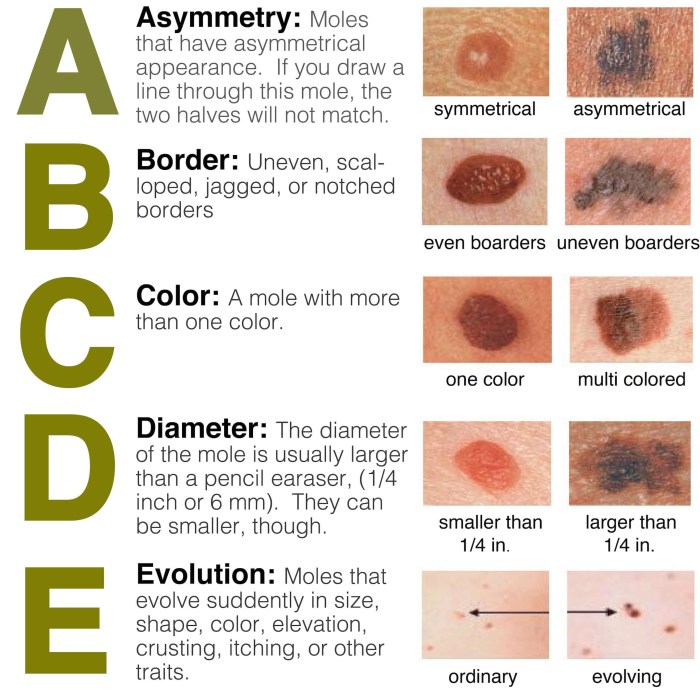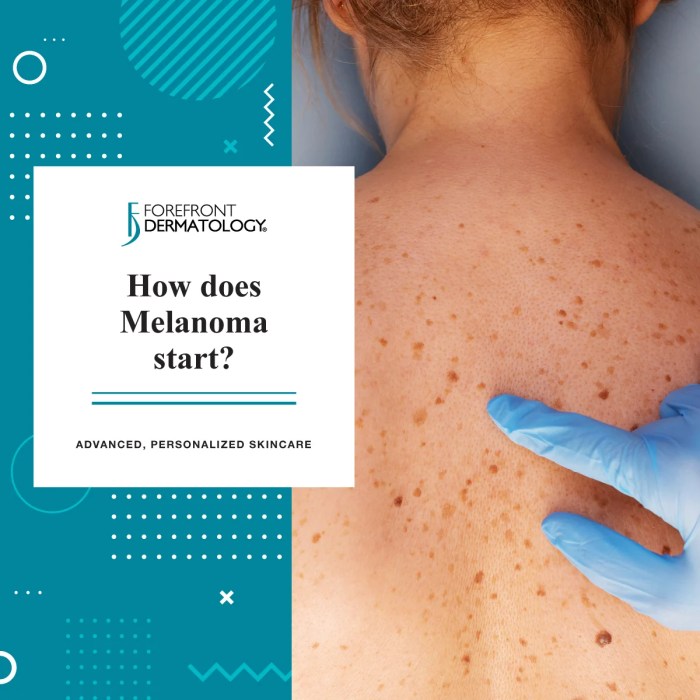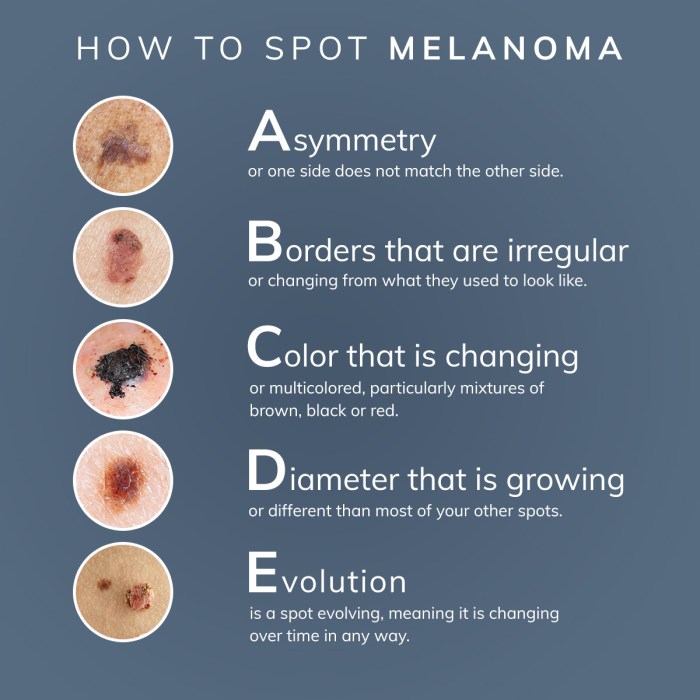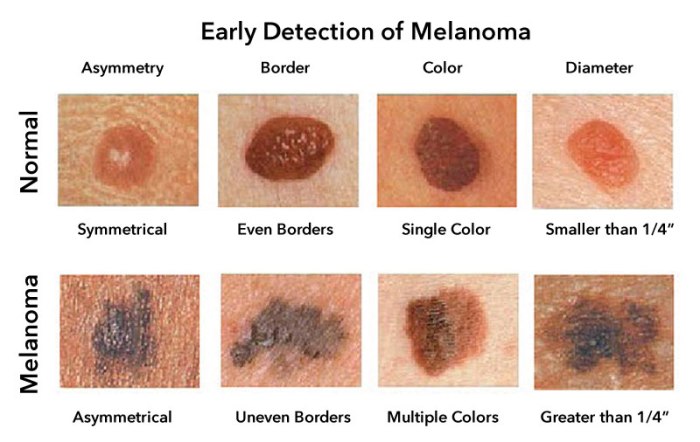Do i have melanoma quiz – Wondering if that mole is a melanoma? Take our “Do I Have Melanoma?” quiz to find out. Melanoma is the deadliest form of skin cancer, so it’s important to catch it early. This quiz will help you assess your risk factors and symptoms, and determine if you need to see a doctor.
Melanoma Overview

Melanoma is the most serious type of skin cancer, developing from melanocytes, cells that produce melanin, the pigment that gives skin its color. It can occur anywhere on the body, but is most common on sun-exposed areas such as the back, chest, legs, and face.
Melanoma is characterized by the uncontrolled growth of abnormal melanocytes, forming a mole or lesion that can change in size, shape, or color over time. It can be difficult to distinguish from benign moles, making early detection crucial for effective treatment.
Risk Factors
Exposure to ultraviolet (UV) radiation from sunlight or tanning beds is the primary risk factor for melanoma. Other risk factors include:
- Fair skin, light-colored eyes, and blond or red hair
- Family history of melanoma
- Multiple or atypical moles
- Sunburns, especially blistering sunburns
li>Weakened immune system
Prevalence and Incidence
Melanoma is the fifth most common cancer in the United States, with an estimated 99,780 new cases and 7,650 deaths in 2022. The incidence of melanoma has been rising steadily over the past few decades, particularly among younger adults.
Importance of Early Detection
Early detection and diagnosis of melanoma are critical for successful treatment. Regular skin self-exams and professional skin checks can help identify suspicious lesions and lead to timely intervention. The earlier melanoma is detected, the higher the chances of successful treatment and a favorable prognosis.
Melanoma Symptoms

Melanoma, the most severe type of skin cancer, can manifest in various ways. Recognizing its symptoms is crucial for early detection and timely treatment.
Early signs of melanoma often resemble harmless moles. However, specific characteristics and changes can indicate the presence of melanoma.
Common Melanoma Symptoms
| Symptom | Appearance | Body Parts |
|---|---|---|
| Asymmetry | One half of the mole is different from the other | Back, chest, legs |
| Irregular Border | Edges are ragged, notched, or blurred | Back, chest, legs |
| Color Variation | Multiple shades of brown, black, or tan, or areas of white, gray, red, or blue | Back, chest, legs |
| Diameter | Larger than 6 millimeters (about the size of a pencil eraser) | Back, chest, legs |
| Evolution | Changes in size, shape, or color over time | Back, chest, legs |
Besides these general symptoms, there are specific warning signs to look for:
- New moles that appear after age 30
- Moles that itch, bleed, or crust over
- Moles that have a raised, pearly, or smooth surface
The ABCDE rule is a helpful mnemonic for identifying potential melanomas:
- Asymmetry
- Border irregularity
- Color variation
- Diameter greater than 6 millimeters
- Evolution over time
Melanoma Diagnosis

Diagnosing melanoma involves a thorough examination by a dermatologist, often using specialized techniques. Understanding the procedures involved can help you stay informed about your skin health.
Dermatologist’s Role
Dermatologists are medical professionals specializing in skin diseases, including melanoma. They are trained to recognize suspicious skin lesions and perform diagnostic tests to confirm or rule out a diagnosis.
Skin Exam
A skin exam is a visual inspection of the skin for any unusual or concerning lesions. It typically involves:
- Examining the entire skin surface, including the scalp, nails, and soles of the feet.
- Using a dermatoscope, a magnifying device that enhances the visibility of skin structures.
- Documenting the size, shape, color, and other characteristics of any suspicious lesions.
Biopsy, Do i have melanoma quiz
If a skin exam raises concerns, a biopsy may be recommended. A biopsy involves removing a small sample of the suspicious lesion for examination under a microscope. This helps determine if the lesion is cancerous and, if so, the type of melanoma.
Sentinel Lymph Node Biopsy
In some cases, a sentinel lymph node biopsy may be performed to check for the spread of melanoma. This procedure involves injecting a dye or radioactive tracer near the primary melanoma site. The dye or tracer travels to the nearest lymph nodes, which are then removed and examined for the presence of melanoma cells.
Melanoma Treatment

The treatment approach for melanoma depends on the stage and severity of the cancer. A combination of therapies may be recommended to achieve the best possible outcome.
Treatment Options
The primary treatment options for melanoma include:
- Surgery:The most common treatment for melanoma is surgical excision, where the cancerous tissue is removed along with a margin of healthy tissue to prevent recurrence.
- Radiation Therapy:High-energy radiation is used to target and destroy cancer cells. It may be used before or after surgery to reduce the risk of recurrence or treat advanced melanoma.
- Targeted Therapy:This treatment uses drugs that specifically target the genetic mutations or proteins involved in melanoma growth. It is often used for advanced or metastatic melanoma.
Factors Considered in Treatment Selection
The choice of treatment depends on several factors, including:
- The stage and thickness of the melanoma
- The location of the melanoma
- The patient’s overall health and age
- The presence of any other medical conditions
Potential Side Effects and Outcomes
Each treatment option has potential side effects and outcomes that should be carefully considered:
- Surgery:Risks include infection, scarring, and nerve damage.
- Radiation Therapy:Side effects can include skin irritation, fatigue, and nausea. Long-term effects may include tissue damage and secondary cancers.
- Targeted Therapy:Common side effects include skin reactions, gastrointestinal problems, and fatigue. Some targeted therapies can also cause more serious side effects, such as liver damage or heart problems.
The overall outcome of melanoma treatment depends on the stage of the cancer at diagnosis and the effectiveness of the treatment plan.
Taking the “Do I Have Melanoma?” quiz can help you assess your risk. If you’re interested in learning more about Spanish, you can download the asi se dice level 1 pdf . This resource provides a comprehensive introduction to the language, covering basic grammar and vocabulary.
After reviewing the pdf, you can return to the melanoma quiz to continue assessing your risk.
Melanoma Prevention

Melanoma is a serious form of skin cancer, but it is largely preventable. Here are some simple and effective measures you can take to reduce your risk:
Limit sun exposure:Avoid prolonged exposure to the sun, especially during peak hours (10am to 4pm). Seek shade or use a sun umbrella when outdoors.
Use sunscreen:Apply a broad-spectrum sunscreen with an SPF of 30 or higher to all exposed skin, even on cloudy days. Reapply every two hours or more often if swimming or sweating.
Wear protective clothing:Cover up with long-sleeved shirts, pants, and a wide-brimmed hat when outdoors. Choose fabrics that block UV rays, such as cotton or linen.
Get regular skin self-examinations:Examine your skin regularly for any new or changing moles or spots. Pay attention to size, shape, color, and border. If you notice any suspicious changes, consult a dermatologist promptly.
Consider genetic testing:Individuals with a family history of melanoma or multiple atypical moles may consider genetic testing to identify mutations that increase their risk. This can help them take preventive measures and monitor their skin more closely.
FAQ Guide: Do I Have Melanoma Quiz
What are the risk factors for melanoma?
Risk factors for melanoma include fair skin, a family history of melanoma, and exposure to ultraviolet (UV) radiation.
What are the symptoms of melanoma?
Symptoms of melanoma can include a change in the size, shape, or color of an existing mole, or the appearance of a new mole that is irregular in shape or color.
How is melanoma diagnosed?
Melanoma is diagnosed through a skin exam and a biopsy.
How is melanoma treated?
Treatment for melanoma depends on the stage of the cancer and may include surgery, radiation therapy, or chemotherapy.